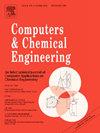A hybrid Kalman filter and physics-informed neural network approach for leakage detection and localization in heat exchanger networks
IF 3.9
2区 工程技术
Q2 COMPUTER SCIENCE, INTERDISCIPLINARY APPLICATIONS
引用次数: 0
Abstract
Leakage in heat exchanger network poses a critical latent threat to energy efficiency and process safety in industrial operations. This paper presents an integrated detection framework that synergistically combines Kalman Filter with physics-informed neural networks enable real-time detection and localization of leakage events. Kalman Filter is employed to preprocess noisy sensor data and accurately estimate key parameters, most notably the heat transfer coefficient, which is highly sensitive to leakage-induced deviations. These refined estimates serve as inputs for physics-informed neural networks, whose training is constrained by fundamental physical laws, enhancing fault detection accuracy. Validation via extensive simulations and experimental case studies demonstrates that the proposed framework reliably detects leakage flows as low as 1%, with an average inference time of only 0.76ms per sample. Compared with benchmark models, the proposed framework reduces prediction RMSE by 7%–15% and increases F1-score by 3%–5%, while maintaining millisecond-level responsiveness suitable for industrial real-time monitoring and precisely localizes the affected unit within complex heat exchanger network configurations. The integration of advanced state estimation and physics-constrained learning offers a robust strategy for improving the reliability, safety, and energy efficiency of industrial heat exchanger systems.
一种混合卡尔曼滤波和物理信息神经网络方法用于热交换器网络的泄漏检测和定位
在工业运行中,换热器网络泄漏对能源效率和过程安全构成了严重的潜在威胁。本文提出了一个集成的检测框架,该框架将卡尔曼滤波器与物理信息神经网络协同结合,能够实时检测和定位泄漏事件。采用卡尔曼滤波对传感器数据进行预处理,准确估计关键参数,特别是传热系数,该参数对泄漏引起的偏差高度敏感。这些改进的估计作为物理信息神经网络的输入,其训练受基本物理定律的约束,提高了故障检测的准确性。通过广泛的模拟和实验案例研究验证表明,所提出的框架可靠地检测低至1%的泄漏流,每个样本的平均推断时间仅为0.76ms。与基准模型相比,所提出的框架将预测RMSE降低了7%-15%,f1得分提高了3%-5%,同时保持毫秒级的响应能力,适合工业实时监控,并在复杂的换热器网络配置中精确定位受影响的机组。先进的状态估计和物理约束学习的集成为提高工业热交换器系统的可靠性、安全性和能源效率提供了一个强大的策略。
本文章由计算机程序翻译,如有差异,请以英文原文为准。
求助全文
约1分钟内获得全文
求助全文
来源期刊

Computers & Chemical Engineering
工程技术-工程:化工
CiteScore
8.70
自引率
14.00%
发文量
374
审稿时长
70 days
期刊介绍:
Computers & Chemical Engineering is primarily a journal of record for new developments in the application of computing and systems technology to chemical engineering problems.
 求助内容:
求助内容: 应助结果提醒方式:
应助结果提醒方式:


